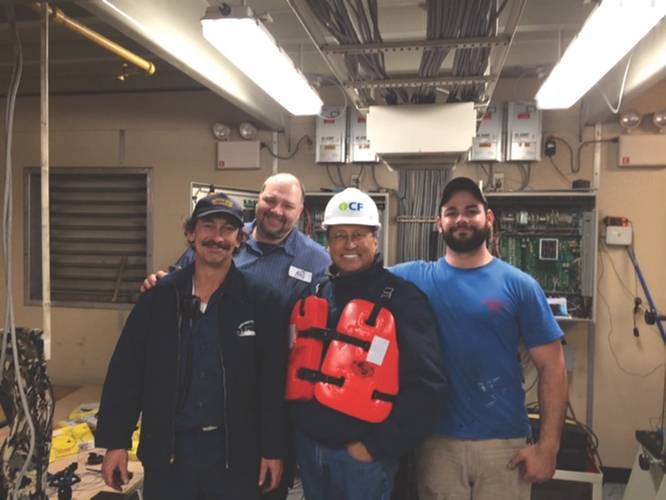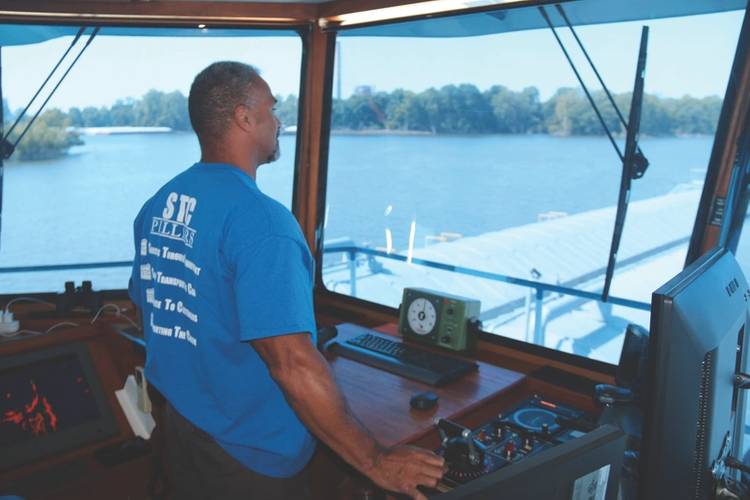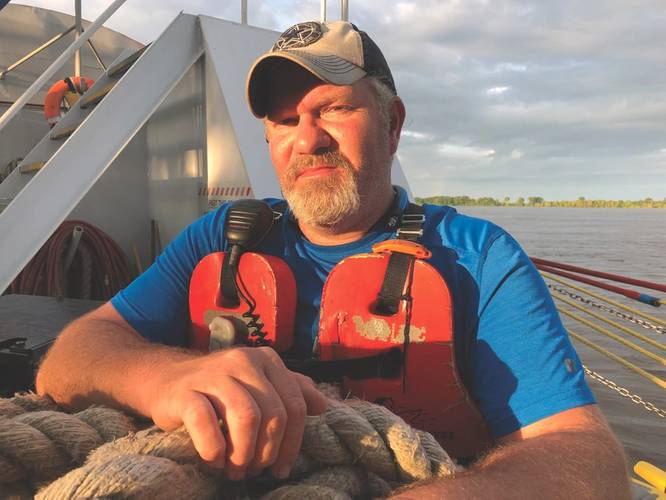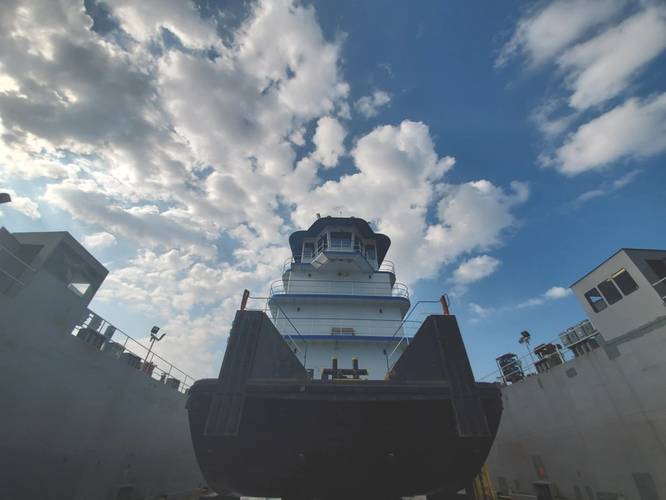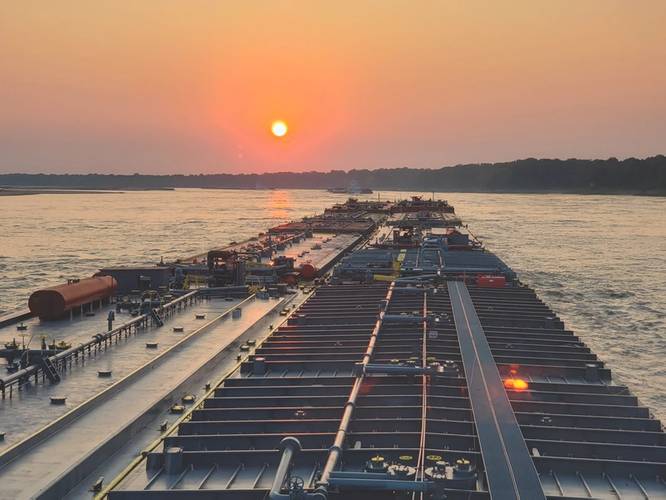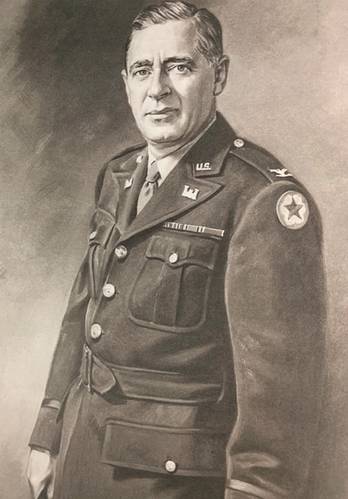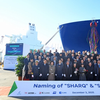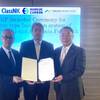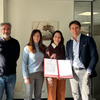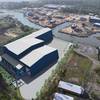Interview: Ed Grimm, CEO, Southern Towing Company
“In God we trust. All others must have data.”
When Ed Grimm took the helm of Southern Towing Company (STC)as President and CEO, he inherited an enviable team of leaders, engineers, mentors, communicators and analysts. Today STC is a clear leader on the inland waterways, pioneering and proving the business and safety value of Z-Drives on the river towboats.
How did you come to the top spot at Southern Towing Company?
I started in the energy industry at 16 working at an oil storage depot in New York Harbor, working there through high school and putting myself through college. After college I went to Coast Guard OCS and was fortunate to get a vessel, as only about 10 percent of the OCS grads at that time received vessel assignments. I spent 310 days at sea the first year, a great opportunity to get underway time.
And we started the second year on the same clip, and after 17 months as a commissioned officer I got an opportunity for my own command, reporting to a patrol boat as an ensign. It was humbling and it was scary in some respects, but it got me to Texas where I met my wife, who was working for a marine company.
How did your career (and your life) change trajectory with this meeting?
The marine company didn’t want to lose my wife with my transfer to my next duty assignment, so they made me an offer I couldn’t refuse. I left active duty, stayed in the reserves, and stayed in Texas. She and I worked together for the first 11 years of our marriage which was awesome.
The company that I was running was bought by Houston Marine Services, so we moved from the Port Arthur to Houston where I spent 18 years, finishing as the Chief Operating Officer before the company was sold. I then spent 10 years with Martin Midstream Partners running Martin Marine. About five years ago a private equity firm came knocking, so I came to Memphis to run Southern Towing as its CEO.
I see from some of the patents hanging on your wall that you have a vested interest in the technology side of marine.
I was fortunate on my first (USCG) ship that the captain believed in mentoring young people. I was a deck officer but I asked if I could get involved in engineering so I could learn how the propulsion takes me from Point A to Point B. I always believed that when you go out to sea, if something breaks down and you don’t fix it, you’re not getting home. The captain said that as long as it didn’t affect my deck duties, I could approach the head of engineering, who was a gruff warrant officer. But he took me under his wing and taught me a lot about engineering.
When I left the vessel I was the Damage Control Assistant, which was normally an engineering function, so it was a great opportunity to get experience on the deck and get experience in engineering.
Perhaps more importantly, it fostered my idea that engineering is as exciting as command.
From that point I got involved in wanting to find engineered solutions. If you look on that wall there’s a blue frame, and it says “the greatest joy in life is accomplishing what others say you cannot do.” And anytime someone says it’s never been done before, or “you can’t do this,” it just sets my mind in motion that I’m going find a way.
So tell me about the patents you hold.
The first looked at heating product on a barge using waste gas heat from the main engine on the tug. If you heat product on a barge, typically you’re running the boiler and burning fuel, meaning it’s a cost and also a carbon footprint. Waste gas heat has common uses in the shipping industry, but not in the barging industry. I hypothesized you could take the heat from the exhaust of the main engine on the tow boat and use it to heat product on a barge; albeit, you have to circulate heat transfer oil across the interface between the barge and the tug. I worked with a naval architect to help put the idea together and we were awarded the patent.
Another patent is around hot oil products and improving the efficiency of maintaining the heat, i.e. burning less fuel to maintain the temperature of the product. Both of these patents were filed when the International Maritime Organization (IMO) started talking about low sulfur fuel. My theory was that (with the advent of IMO 2020) the price of fuel would spike – the price of diesel fuel would spike – and the cost to heat product on barges would go up. I wanted to find a way to help mitigate that. It’s not that it’s a panacea, but I looked at this as a way to defer or lower the cost to heat product in the inland barge business.
It sounds simple, and what’s funny is you look at a lot of patents – they are simple. There’s a lot of really neat solutions that if people just put them on paper and talked to a patent attorney, they could go out and do it. Imagination drives innovation.
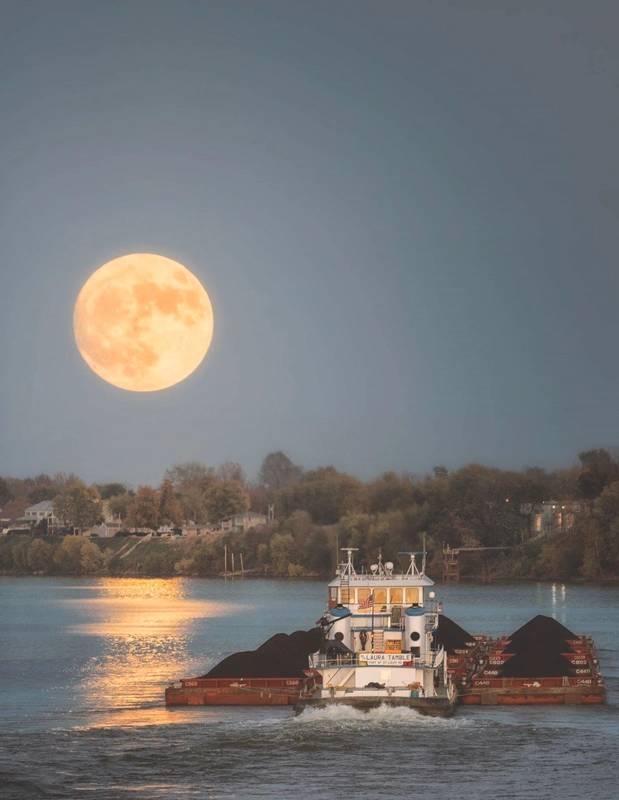 MV Laura Tamble. Photo: Southern Towing Company
MV Laura Tamble. Photo: Southern Towing Company
So, in essence, innovating and staying a step ahead of regulation as a business imperative?
It’s kind of like Subchapter M. Early on we identified our gaps and started to address them to make an easier transition come 2019? An we are very far along.Did we take a risk by doing things that maybe we didn’t have to do? Perhaps. But I think we were far ahead in the preparation for Sub M. So it’s not all about price-per-barrel-moved, it’s total dollars to move a product. So total cost per unit delivered is what traders and customers look at. So how can you help lower the cost without giving away your margin?
When you joined Southern Towing, what attracted you to the position?
It was an opportunity to be a President and a CEO, which I had not experienced at that point. I had run operations, but I was not the CEO. I have a desire to pass on the experiences that I’ve gained over the years to younger executives. Having previously concentrated on petroleum products, I thought it was a great opportunity to learn a different part of the marine transportation industry, which is fertilizers and dry cargo. I knew some of the people (in the business) and I really respected them. I loved the idea of Z-drives, and I thought there was a lot of potential to take those to another level.
How is the Southern Towing that you joined five years ago most the same? How is it most different?
A lot of CEOs of American corporations say that people are their greatest assets, and I think some of that is not sincere. But we really have a great group of professionals at STC, for example VP of HR celebrates 45 years with the company this year.
That’s a long tenure!
Yes it is. His son works here too. Our lead captain has been here almost 40 years. (Top to bottom) it’s just a great group of people that are dedicated to teamwork and serving the customer. One of the senior guys said, “Don’t worry about the mule – just load the wagon.” It’s just a great testament that people are focused on getting the job done.
How do you attract and retain good people?
How do you put your money where your mouth is? Career development. Opportunity and investing in the people. And we have gone way out of our way to put together a career development ladder that is very much in line with how military organizations spell it out. And every position in the company has practical factors you need to accomplish before you can attain that position. They’re all published. There’s a method. There’s a way to help them succeed, there’s a way to get them help on their vessel to learn the practical factors. Everything is based on a best qualified, not a seniority basis. And as much as that may upset some of the people who believe in the seniority method, it really reinforces that our focus is on quality and what you put in is what you get out. So you reap what you sow. Everything is databased. I have a phrase: “In God we trust. All others must have data.”
And we want people to come up with data-driven suggestions, solutions or proposals. It shows that people have done some research, and they’ve developed some data, and formed quote/unquote “statistics.” But I have a book that I got my freshman year in college in freshman economics, and it was the first book we had that year, and he handed it out, and it’s “How to Lie With Statistics.” In short it says is you can make statistics say whatever you want. So besides having data, you have to have data that has validity of purpose, not trying to accomplish proving a position.
When you started at Southern Towing, I understand that you rode the boats for 90 days to familiarize yourself with the company outside of the spreadsheets. During those 90 days, what did you find?
Pure pride of the brand. Pure pride of the history and the safety record. That pride of the quality of their crews. I found crews that were worried about the next 60 years and sustainability; worried about their families and their kids. All of the same things that most people worry about. It was an interesting time to get to know individuals, and understand their families and their wants and their needs.
Are you able to keep that effort up? How do you continue that effort to keep connected to your employees?
We have a regular conference call. We tune in all the boats at the 11:30 watch change so that we can have as many crew on the call, as many crew members that the captain thinks is safe for the environment they’re in. Every once in awhile, someone will miss the call and they’ll call me on my cell phone later. We talk to them on a regular basis, because I like them hearing from the horse’s mouth versus the rumor mill, which is a cancer.
I could easily write memos, but a lot of people don’t take time to read, and then they interpret. I’d rather they hear it directly from me. Everybody has my cell phone and all employees can call. I have some captains that call on a regular basis. You have to communicate to build a relationship. You have to have a relationship in order to build trust. A lot of times the marine professionals out in the field don’t trust the people on shore, so we worked hard at building that trust. Trust is doing what you say you’re going to do.
STC is a big company with many moving parts. Distill for me the essence of the company.
It’s health, it’s safety, it’s security, it’s environmental, its quality and it’s training. That is our license to operate, and if we take care of those things first, a lot of times everything else just falls into place. I like to say we are in a 5 mph business – nothing’s so important to rush and sacrifice safety.
As you have come from the petroleum side to moving fertilizer, is there any material difference in the two industries or the cargos?
If you’re just a transporter, then it’s a box. Barge transportation is barge transportation. What you’re trying to understand is what’s important to the customer, and how we can offer strategy or insight to help them better reach their goals. And so, I think the moving from Point A to Point B is the same – a barge is a shoebox in the water, you have engines, you have transmissions. But to understand what’s important to the customer, I think, is the biggest difference. I try to use that knowledge to better understand how I can help solve problems, because I think we are problem solvers in addition to being transporters of product.
When you look at your competitive view today, what do you see?
Our main concentration is around moving fertilizer, but there are other people that haul fertilizer. I don’t take for granted that there’s only a few (competitors) in it, because the moment you assume a position of safety, is the moment you compromise your drive to get better every day. We have some great barge lines in this country that do a great job moving product. But I don’t look at them necessarily as competitors. I try to focus on the customer – the needs of the customer – and how can I differentiate myself because everybody has boats, everybody has barges. How do you differentiate? That’s in person-to-person service, that’s in problem solving, that’s in flexibility. I think we have to give the customers things that differentiate us from other people that have boats and barges.
A point of differentiation for me is the fact that Southern Towing has been a pioneer in its use of Z-Drives on inland towboats. How does that help you a competitive advantage and help to better serve your customers?
The Z-Drive itself is a wonderful application for the inland business. I have to say when Southern was first looking at it, I was a skeptic. In fact, I was working with a another naval arch to pursue another way of improving efficiency in propulsion.
It wasn’t until I got to Southern and started really digging in that I fully understood the benefits of the Z-Drive propulsion system. And I am now a firm believer that in river segments where tow size is restricted – i.e. locks, locking systems, or the canal – that the Z-drive has a tremendous advantage over conventional propulsion.
We have, with a particular customer, developed data that more than supports this belief, and in fact it is surprising how much of an advantage it is. In fact we’ve signed a contract to build tw new Z-drive boats (at Steiner Shipyard in Bayou La Batre, Ala.), and we hope to sign an additional option to build multiple more.
Can you be more specific on the efficiencies?
From a performance, speed over ground, miles attained per day, upriver-downriver, we compete evenly or better than vessels that have significantly more horsepower than us, so consequently, less fuel consumption. But I think, over a term, I’ll say the efficiency gains are between 22-30 percent, depending on application.
That’s significant …
It is significant. There are still naysayers, but that’s what makes the world go ‘round. Why does someone like a Chardonnay and someone like a Cabernet? Beauty is in the eye of the beholder, but I think we have strong, factual evidence and we believe in it enough that we’re continuing to build.
As you know, technology only moves the ball so far, so fast. Without support, particularly when it’s a new application, even the best tech can fail. We understand that you’ve built a good relationship with ZF that covers the lifecycle maintenance.
When I came to Southern people would ask ‘why are you going there? Those Z-drives are horrible.’ I think in the early years that Southern owned the Z-drives, they had operational reliability issues, meaning the percentage of the year were they up and running. There were questions in the industry as to the units robustness.
At the time ZF acquired ownership of HRP, a Dutch manufacturer, in 2009, it had taken a thruster designed for blue water and brought it straight to the river. In my belief, it’s kind of like the first-year model of a car, not just a car but a revolutionary car. Typically those first-year models – one, two or three – were not as refined as they were later. And there were design criteria in a Z-drive that could be improved.
My first year here, I spent a good amount of time looking into the issues we were having, specifically asking why were we having these failures? What contributes to the failures? Are they human in nature? Are they environmental in nature? Are they design in nature? We brought in an outside failure engineer, a consulting company, to help us analyze the actual failures and see if we could point to the causes to help us look for a solution. In my first 12 months my conversations with ZF were challenging to them. There was friction, but there was also a push to work together to solve the problem. I think too many customers point at vendors and say, “you have to solve the problem”
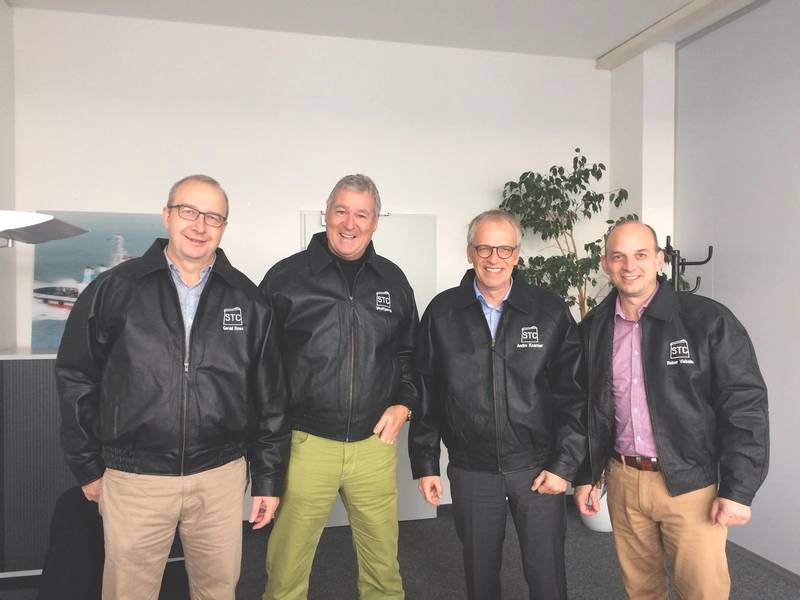 ZF ... From Supplier to Teammate: Pictured above are members of the ZF Marine team that earned STC Service Award jackets, a rare accomplishment for anyone outside of company. Pictured are: L to R: Gerald Rowe, Head of R&D ZF Marine, Wolfgang Schmid, Head of ZF Business Unit Marine and Special Driveline, North America; Andre Koerner, Head of Product Line Commercial and Fast Craft, ZF Marine and Reiner Viebahn – Plant Manager ZF Krimpen (commercial thruster production).
ZF ... From Supplier to Teammate: Pictured above are members of the ZF Marine team that earned STC Service Award jackets, a rare accomplishment for anyone outside of company. Pictured are: L to R: Gerald Rowe, Head of R&D ZF Marine, Wolfgang Schmid, Head of ZF Business Unit Marine and Special Driveline, North America; Andre Koerner, Head of Product Line Commercial and Fast Craft, ZF Marine and Reiner Viebahn – Plant Manager ZF Krimpen (commercial thruster production).
And vendors should solve problems, but sometimes vendors don’t take the care to get close enough to see it from the customer’s point of view. And one of the neatest things that ZF did was they sent their head of R&D to Memphis for three days to understand our application of their product, and to see if a better understanding on their part of the application could help them in looking at solutions.
And while they were here, we presented them with a bunch of our failure analysis and they went back to Germany and did their homework. They came back and said, “We think you have something on this particular area. Let’s work together.” And from that point on, we have refined the Z-drive we presently use, and the uptime has improved to a point that in 2017 we had 100 percent uptime on all of our ZF thrusters.
So what were some of the physical manifestations of the changes that were made to the thrusters?
One was how the nozzle and lower unit were attached to the steering tube that goes to the vessel. We worked with ZF to change the design and spec of the hardware.
That, along with some other design modifications, resulted in the connectivity points strengthened so much that it eliminated that issue.
Another was using vibration analysis to detect minor changes in the propeller from striking debris in the water, thus catching it early and changing out a propeller versus leaving it on, with the vibration causing damage.
Are the Z-drives as robust as conventional? No. But life is a compromise and in certain applications it can outperform conventional propulsion. In other applications, conventional solutions are more appropriate.
So when you look at some of the performance parameters that you count as the key to the Z-drive, what are the top advantages?
Maneuverability. They can maneuver so much better than conventionals. The conventional propeller, as the propeller designers look at it, they have to be able to back with a certain amount of efficiency. In order to give a propeller the ability to back, it takes away from forward performance. The nice thing about the Z-drive is it is designed 100 percent to go in one direction because the thruster itself turns 360 degrees. And in conventionals, you have the rudder that directs the thrust, and some of that thrust slips off the exterior edges of the propeller. You can have a cort nozzle that solves that, but as the thrust comes out, the rudder has to redirect it and it doesn’t do it with 100 percent efficiency. In a way, when you turn a rudder at a 10 or 20-degree angle, it’s almost like a brake. It creates a drag. So the more times you steer, the more drag you’ve inserted into the propulsion model and the less efficiency you have.
No vessel can maneuver a tow into or out of a dock as good as the Z drive. And then you start talking about bumps and bruises on your barges, a lot of which come when you’re docking, undocking, going into a lock, leaving a lock. And sometimes those bumps and bruises turn into incidents.
The safety contribution that Z-drives makes to marine transportation – especially barge marine transportation – is dramatic. If you want to stop, you can turn these thrusters at 90 degrees and you have more of an effect on slowing down the vessel at 90 degrees than you do turning them around 180 degrees. It’s like a big brake. And the ability to stop a tow with a Z-drive in a distance, call it, say, “stopping distance,” is dramatically improved with the Z-drives versus conventionals. And one that a lot of people don’t talk about is the ability to back up quickly, safely.
The ‘best of the best’ (captain) may be able to back, maneuver and steer a tow in the reverse direction, which is difficult with a conventional drive. The Z-drives make it easier, and the enhanced maneuverability really improves our margin of safety.
How has it been getting the captains of your boats to adopt the Z-Drive?
The ones that want to get involved get involved and we aggressively try to invest in them. The Seamen’s Church Institute simulator system in Paducah is awesome, it is just a phenomenal organization.
We now have Z-drive simulations and it has really helped our folks, as initially we went out to the West Coast for the Z-drive simulation training, so we’re blessed to have it right here in the inland system. Bless The Seamen’s Church and what they do, not only from an educational point of view, but what they do for our mariners.
Bottom line, you give them the opportunity and then you put them out on a boat and you let them try. In fact when the downturn in the industry came in late ’15-’17, a lot of people cut their wheelhouse development programs. We kept ours, and to some extent accelerated it. You have to invest in people. On my first day here I told everybody I was going to invest in boats, barges, and people. And if it didn’t fit those categories, I wasn’t going spend money on it until the organization was where I wanted it to be.










